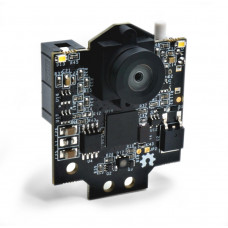Pixy 2 CMUcam5 Version 2.1
Description
The Pixy2 CMUcam5 is smaller, faster and more capable than the original Pixy. Like its predecessor, the Pixy2 can learn to detect objects that you teach it, just by pressing a button. Additionally, the Pixy2 has new algorithms that detect and track lines for use with line-following robots. With these new algorithms, you can detect intersections and “road signs” as well. The road signs can tell your robot what to do, such as turn left, turn right, slow down, etc. The best part is that the Pixy2 does all of this at 60 frames-per-second, so your robot can be fast, too!
No need to futz around with tiny wires — the Pixy2 comes with a special cable to plug directly into an Arduino and a USB cable to plug into a Raspberry Pi, so you can get started quickly. No Arduino or Raspberry Pi? No problem! The Pixy2 has several interfaces including SPI, I2C, UART, and USB with simple communications, so you get your chosen controller talking to the Pixy2 in short order.
The Pixy2 uses a color-based filtering algorithm to detect objects. Color-based filtering methods are popular because they are fast, efficient, and relatively robust. Pixy2 calculates hue and saturation of each RGB pixel from the image sensor and uses these as the primary filtering parameters. The hue of an object remains largely unchanged with changes in lighting and exposure. Changes in lighting and exposure can have a frustrating effect on color filtering algorithms, causing them to break. Pixy2’s filtering algorithm is robust when it comes to lighting and exposure changes.
Wider field-of-view — the previous Pixy version (2.0) had a 60 degree horizontal field-of-view. The new version has an 80 degree field-of-view. Most users want the larger field of view because of the ability to see more of the environment per image. There is some spherical distortion with the new lens, which comes with the wider field-of-view.
Replaceable lens — the M12 lens mount allows you to substitute a different lens if you wish
Adjustable focus — the M12 lens has an adjustable focus that allows focusing on objects at practically any distance, including as close as 0.25”.
Less chromatic distortion — the new lens has virtually no chromatic distortion at the edges, whereas the previous Pixy version had a small amount of chromatic distortion.
Less pixel noise — the new lens has an F-stop of 2.0 vs the previous lens which had an F-stop of over 3.0. This means better light gathering ability, more signal and less noise for a given amount of ambient light. Less noise means better detection accuracy for this new Pixy version.
Everything else about Pixy 2.1 is the same — software, firmware and feature set. Pixy 2.1 is slightly larger, however, adding 0.25 inches to the height and depth of the camera versus Pixy 2.0. And while our cost has increased, we are keeping the distribution and retail cost exactly the same for Pixy 2.1.
Includes
- 1x Pixy2 CMUcam5 (version 2.1)
- 1x Pixy IO to Arduino ISP Cable
- 1x Micro USB Cable
- 1x Mounting Hardware
Features
- Processor: NXP LPC4330, 204 MHz, dual core
- Image sensor: Aptina MT9M114, 1296×976 resolution with integrated image flow processor
- Lens field-of-view: 60 degrees horizontal, 40 degrees vertical
- Power consumption: 140 mA typical
- Power input: USB input (5V) or unregulated input (6V to 10V)
- RAM: 264K bytes
- Flash: 2M bytes
- Available data outputs: UART serial, SPI, I2C, USB, digital, analog
- Integrated light source, approximately 20 lumens
- Version 2.1:
- 80 degree field-of-view
- Replaceable M12 lens
- Adjustable focus
- Less chromatic distortion
- Less pixel noise
- Slightly larger in size than version 2.0
- Dimensions: 1.5” x 1.65” x 0.6”
Documents:
Enter the code in the box below:



